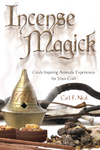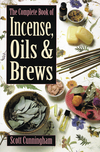The Economics and Politics of Incense

Does that title strike you as odd? The "economics," of incense might seem like a stretch, and "politics?" The truth is that both economics and politics have been greatly influenced by incense at many points in history. While modern techniques, new incense ingredients, and the greater availability of information is causing a new revolution in the incense world, incense has played even larger roles in the distant past. At some points of history, the importance of incense could not be overstated.
Europe
It is hard for us in the twenty-first century to immediately understand how massive the impact of incense was in the ancient world. It has been said that the Roman Empire was built upon mounds of frankincense, and in some ways that is true. The incense trade was a huge part of many economies in Europe, Africa, and Asia; Rome was one of the focal points of that trade. Most of us are familiar with the "silk road," not a single road, but in fact a giant series of roads and trails that connected the three continents into a massive, ancient, trading network. The "silk road" would be more properly called the "spice road" or the "incense road;" yes, silk and other trade goods flowed across the thousands of miles of roads, but it was the rare spices and aromatics that truly made the road an economic lifeline.
Many tiny population centers were transformed into economic empires by their roles as providers of aromatics or their geographic location along the silk road where those aromatics were transported. Many seats of power that have been lost to our popular history (such as Ubar) were once mighty lands that commanded respect and fear because of the economic power of incense.
Most of us have seen Rome in her heyday as envisioned by television and filmmakers. As a result, we have some idea of how Rome may have looked in ancient times. Historians and archeologists have offered us an incredible assortment of Roman technology and political or philosophical writing, so we have some ideas about how Roman life sounded. We know how they dressed, we know how they slept, and we are familiar with the construction of their cities, so we have an idea of how Rome "felt." We know a fair amount about what the Romans ate, so we can even say we know how Rome "tasted."
But how did Rome smell? Based on many historic accounts and modern research, ancient Rome must have smelled of little aside from frankincense. Although that may be overstating things a bit, Rome was a clean city that consumed tons of frankincense weekly. Other resins and incense offerings were made throughout the city and the empire, but frankincense was the king. Much as "king cotton" drove the economy and the history of the United States, "king frankincense" drove a significant portion of the some of the economies of the ancient world, and oft times its history as well.
As the power and economic strength of the Roman Empire grew, so did the trade in rare goods. Kingdoms such as Ma’in, Sheba, Qataban, Hadramaut, and ‘Ad all rose to power because of the trade in frankincense and other aromatics. Incense had the ability to make, or break, large sociopolitical powers. The kingdom of ‘Ad grew to prominence on the frankincense trade and faded away as its neighbors joined in the trade and diminished ‘Ad’s power. Rome was rich, so those who traded with Rome often became rich as well. Clearly incense has had the power, for at least five thousand years, to change politics and economics. The reverse of this is also true.
Early Christians in Rome were certainly a persecuted minority. While rarely taken seriously by Roman leadership in the first days of Christianity, the consensus among many historians is agreement with some of the tales of persecution. Purportedly among these persecutions were Christians forced, under threat of death, to give offerings to Roman gods and goddesses. Of course, giving such an offering would be seen as offense to their true beliefs and some would rather die than betray their hearts. The offering provided: incense.
That would have a lasting effect when the early church grew in power and social acceptance and incense drew the ire of church leaders. The forced offerings of incense had not been forgotten, and incense was cast in a light as being Pagan and evil. As Christianity became the most powerful force in Europe, incense use was sharply, and permanently, reduced in Europe. Performing what was seen as a Pagan practice would remain a bad idea in Europe until the Twentieth Century. In this case, political power changed incense.
This had an economic impact as well. Many of those forgotten kingdoms that were built on the incense trade vanished in the sands of time. Interestingly, they still echo into the Twenty-First Century. Satellites can pick out the ancient trade routes and outlines of cities beneath the shifting sands. Many of the frankincense groves of these ancient kingdoms are still being harvested as the offspring of those ancient trees continue to provide us with incense today.
The most ironic aspect of this tale is that we still have some of the ancient European incense traditions kept alive in Europe. Through the Dark Ages and beyond, one group kept some of the ancient incense from disappearing forever. Even to this day, those organizations that worked to destroy this Pagan practice continue to burn frankincense and other aromatics as part of their services. Only the Christian Church preserved these surviving European incense traditions.
It wasn’t until the Twentieth Century that Europeans began to look at many ancient ideas and practices and felt safe to learn about and use incense. While there are those who deny Europe’s incense traditions, those traditions are there if you look for them. It is reasonable to believe that as archeology uncovers more about life in ancient Northern Europe, unknown incense practices will be revealed.
Asia
In Asia, incense played a larger role throughout the overall course of history than in Europe. Incense has a much deeper impact in Asian history over the course of millennia as opposed to the West where the importance of incense waxes and wanes over time. The lands that we know today as India, China, Japan, Korea, Indonesia, and Tibet are all rich sources of incense tradition, innovation, and ritual.
While prehistoric incense use in Asia likely arose from similar circumstances as Europe, the concept of incense was elevated to an art form in many parts of Asia. For the most part, European incense traditions were limited to the burning of aromatics on hot coals. In Asia, while incense burning on hot coals certainly grew into a complex art of its own, incense pellets (likely an outgrowth of herbal medicine), incense sticks, seals, trails, and more advanced incense use and forms evolved.
From a simple bit of fragrant plant, smoldered on the hot coals from a fire, came complex combinations of woods, resins, and leaves (held together with binders) burned in a carefully prepared burner filled with pure ash and specially made charcoal. Specialized tools were developed and highly detailed rituals developed before ancient Asian incense masters developed self-burning incense such as the now-familiar incense stick. In parts of ancient Asia, incense served as a spiritual offering that carried prayers to the heavens, but it also served to fumigate, demonstrate wealth, help with meditation, and even to demonstrate the skills of a gentleman.
In ancient Japan, the skills of a samurai were not limited to martial abilities. A well-rounded gentleman was also expected to be extensively educated as well as a skilled arranger of flowers and maker of incense. The famous Japanese tea ceremony includes the use of incense and, although it is less known, there is a corresponding incense ceremony known as kodo. Just as intricate and ritualistic as the tea ceremony, it is a rare honor to be invited to a kodo ceremony hosted by a master. Social status could be dramatically impacted by one’s skills with these varied arts, and social status was a key to political power.
By the Fifteenth Century, Japan was home to some of the most skilled incense makers in history. While incense was nearly forgotten in Europe, in Asia several different versions of the amazing, self-burning incense stick were in wide use. The incense censer itself was raised to a form of high art designed to maximize performance while giving joy to the eye. Complex combinations of ingredients from around the world were developed under the skilled eyes of master incense makers. As new ingredients were added to their incense "vocabulary," they were studied and carefully incorporated into the existing traditions. Many in the West are stunned to learn that there is incense that is more expensive, ounce for ounce, than platinum. It is hard for some of us to even conceive any kind of incense to be so valuable, but the incredible ingredients and their masterful combination are still respected in Asia.
Perhaps nothing helped ensure the devotion to incense in Asia more than Buddhism’s embrace of it. While the vast majority of incense we see in America today is of the lowest imaginable quality, the Buddhist use of incense was an important factor in the preservation of complex, expertly created, natural incense. Buddhism is a potent social and, to an extent, political power. Buddhism’s importance to many Asian societies will likely continue to provide skilled incense masters to practice their trade for the foreseeable future. In this case, politics embrace incense. This also makes incense a tool to demonstrate one’s wealth through the purchasing of incense filled with rare materials and then setting fire to them.
The Modern World
Even today, incense drives economics and politics. While we might feel far removed from these issues, they still impact many people. Take the case of sandalwood. Verging on extinction in India, poaching of sandalwood has forced the national government to enact laws to preserve and protect this important natural resource. International treaties and national policies have been impacted by the sandalwood trade. It is a very valuable commodity and at the heart of economies of many communities. This gift of the Earth has been respected since ancient times; that entwinement with human culture will hopefully continue for many generations yet to come.
I don’t want to give anyone the impression that the incense trade is driving the extinction of sandalwood. In truth, incense use is only a tiny portion of the trade in sandalwood, with the perfume industry leading the use. Nevertheless, incense certainly does create some of the demand for sandalwood, and sandalwood’s politics and economics reverberate through the incense world. Australia’s effort to rejuvenate sandalwood populations is another example of this impact.
The case of aloeswood is another modern example of the impact of a cherished incense ingredient, the heart of the kodo ceremony, on politics and economics of many different people. Aloeswood supply, demand, and often incredibly high prices, have driven many people to enter the trade. It has also driven modern research and efforts at preservation and harvestable population expansion. A few decades ago, it was commonly believed that aloeswood could not be farmed, but cooperative research between countries around the world is yielding commercially viable, sustainable aloeswood populations. Economics and politics will likely be impacted by aloeswood for centuries to come.
Incense, sometimes directly, and at other times indirectly, has had an impact on the economics and politics of the world since the beginning of written history. While incense can't be given credit for being the primary force impacting societies, it has certainly played a role in shaping us for millennia. The humble little stick of incense in your censer doesn't seem quite so insignificant when you understand what it represents in terms of the history of humanity.
About Carl F. Neal
Related Products


is subject to certain Terms and Conditions